2018-12-06 - Nº 188
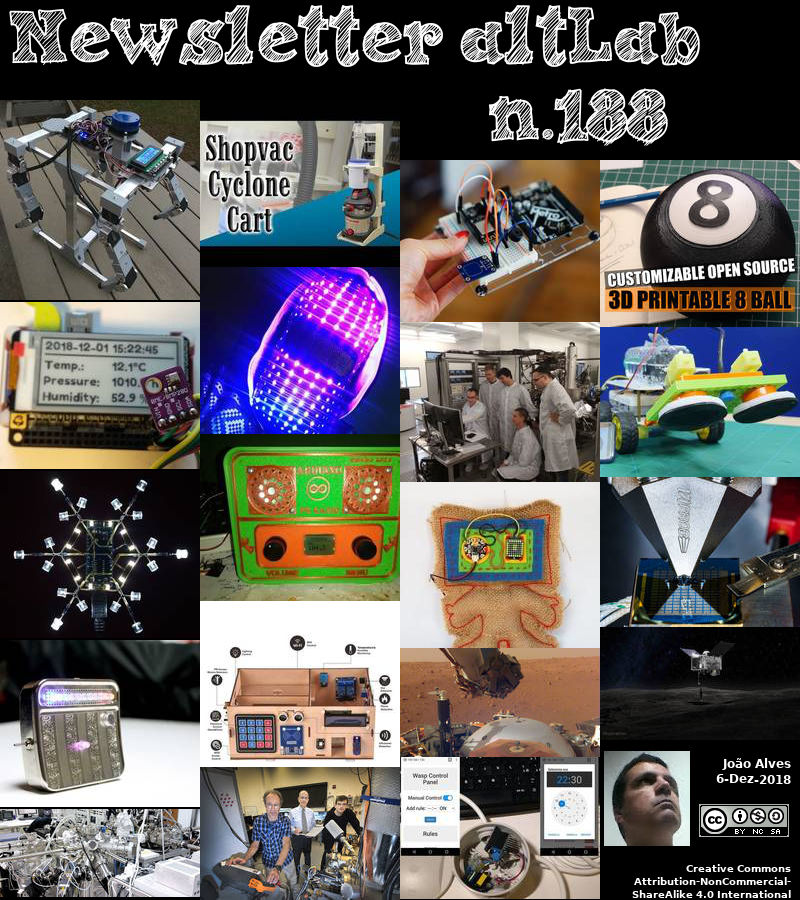
Editorial
Esta é a Newsletter Nº 188 que se apresenta com o mesmo formato que as anteriores. Se gostar da Newsletter partilhe-a!
Todas as Newsletters encontram-se indexadas no link.
Esta Newsletter tem os seguintes tópicos:
Faz anos hoje que nascia, em 1586, Niccolò Zucchi. Este astrónomo italiano projectou um dos primeiros telescópios reflectores, anteriores aos de James Gregory e Sir Isaac Newton. Como professor do Colégio dos Jesuítas em Roma, Zucchi desenvolveu um interesse pela astronomia a partir de uma reunião com Johannes Kepler. Com este telescópio, Zucchi descobriu os cinturões do planeta Júpiter (1630) e examinou os pontos em Marte (1640). Ele também demonstrou (em 1652) que os fósforos geram em vez de armazenar luz. O seu livro "Optica philosophia experimentalis et ratione a fundamentis constituta" (1652-56) inspirou Gregory e Newton a construir telescópios melhorados.
Faz também anos hoje que nascia, em 1778, Joseph Louis Gay-Lussac. Este Químico francês é mais conhecido pelo seu trabalho em gases. Em 1805, ao fazer explodir juntos volumes específicos de hidrogénio e oxigénio, Gay-Lussac descobriu que eles combinaram na proporção de 2: 1 em volume para formar água. Em 1808, depois de pesquisas usando outros gases, ele formulou sua famosa lei de combinar volumes - que quando os gases combinam seus volumes relativos possuem uma relação numérica simples entre si (por exemplo, 1: 1, 2: 1) e seu produto gasoso ( sob pressão e temperatura constantes). Ele desenvolveu técnicas de análise química quantitativa, confirmou que o iodo era um elemento, descobriu o cianogénio, melhorou o processo de fabricação de ácido sulfúrico, preparado de potássio e boro (1808).
Faz igualmente anos hoje que nascia, em 1835, Wilhelm Rudolph Fittig. Este Químico orgânico alemão é famoso pelo seu extenso trabalho de sintetizar compostos orgânicos no final do século XIX. A acção do sódio em compostos orgânicos descobertos por Wurtz (1817-84), foi estendida por Fittig usando uma mistura de um aromático e alquil halóide para produzir homólogos de benzeno. Fittig preparou pinacones (que ele denominou), difenil, fenantreno (1872), cumarona (1883), tolueno (com Tollens em 1864) e muitas outras substâncias. Ele separou vários compostos aromáticos do alcatrão de carvão, estudou as reacções de ácidos insaturados. Fittig propôs as estruturas corretas para as quinonas e (1871, com Ira Remsen) para a piperina alcalóide que dá ao tempero pimenta preta seu sabor e cheiro.
Faz também anos hoje que nascia, em 1863, Charles Martin Hall. Este Químico americano inventou o método electrolítico barato de extrair alumínio do seu minério, permitindo o amplo uso comercial deste metal. Enquanto jovem químico, ele experimentou num abrigo de madeira, com a intenção de encontrar um método para separar o alumínio do seu minério. No início, ele não teve sucesso, mas depois percebeu que precisava de um solvente não aquoso para o óxido de alumínio durante a electrólise. Em 23 de Fevereiro de 1886, Hall descobriu que a criolita fundida (o fluoreto de alumínio e sódio mineral) era um solvente adequado e, usando eléctrodos de carbono com baterias caseiras, produziu os seus primeiros pequenos glóbulos de alumínio. Em 1914, o processo de Hall tinha baixado o custo do alumínio, anteriormente um metal precioso usado para jóias finas, para 18 centavos de dólar por libra-peso.
Faz igualmente anos hoje que nascia, em 1900, George Uhlenbeck. Este Físico holandês-americano que, com Samuel A. Goudsmit, propôs o conceito da rotação do electrão (Jan 1925) que era um meio inteiro. Isto forneceu o “quarto número quântico” antecipado por Wolfgang Pauli. Na sua experiência, um feixe horizontal de átomos de prata deslocando-se através de um campo magnético vertical foi deflectido em duas direcções de acordo com a interacção da sua rotação (subida ou descida) com o campo magnético. Esta foi a primeira demonstração desse efeito quântico e uma confirmação precoce da teoria quântica. Além do trabalho fundamental sobre mecânica quântica, Uhlenbeck trabalhou na estrutura atómica, na teoria cinética da matéria e ampliou a equação de Boltzmann para gases densos.
Por fim, faz anos hoje que nascia, em 1920, George Porter. Este químico inglês, recebeu uma parte do Prémio Nobel da Química de 1967, com o inglês Ronald Norrish e o alemão Manfred Eigen, "pelos seus estudos de reações químicas extremamente rápidas, afretado por perturbar o equilíbrio por meio de pulsos de energia muito curtos". Porter mostrou como o método de fotólise por flash - uma técnica para observar os estágios intermediários de reacções químicas muito rápidas - pode ser estendido e aplicado a muitos problemas diversos de física, química e biologia. Um exemplo é o exame da fotossíntese. Ele estendeu essas técnicas para as regiões de nano-segundos e pico-segundos.
Nesta semana que passou ficámos a saber que a reparação da câmara do Hubble fez 25 anos. A NASA manteve sua respiração quando sete astronautas do vaivém espacial Endeavour alcançaram o Telescópio Espacial Hubble a 568 quilómetros da Terra. A sua missão: reparar uma falha devastadora no espelho primário do telescópio. Com o tamanho de um autocarro escolar, o Telescópio Espacial Hubble tem um espelho primário de 2,4 metros. O maior telescópio óptico já lançado ao espaço, onde podia observar o universo livre dos efeitos distorcidos da atmosfera da Terra, o Hubble tinha muito a seu redor. Mas depois das primeiras imagens recebidas e cuidadosamente analisadas após a implantação do telescópio em 25 de Abril de 1990, ficou claro que algo estava errado: as imagens estavam turvas.
Também esta semana ficámos a saber que depois de 26 sucessos sequenciais, a SpaceX não conseguiu pousar Falcon 9. É o primeiro acidente desde 2016. No entanto a carga composta por mais de sessenta e quatro satélites foi colocada em orbita com sucesso. E foram batidos pelo menos quatro recordes, o recorde americano para colocação de mais satélites, o maior numero de lançamentos num ano (19). O lançador (booster) designado por B1046 foi lançado pela terceira vez e nas três plataformas de lançamento disponíveis - no pad 39A do Kennedy Space Center, no complexo de lançamento 40 no Cabo Canaveral, e agora no complexo de lançamento 4E na Base aérea de Vandenberg na California.
Na Newsletter desta semana apresentamos diversos projetos de maker assim como um modelo 3D que poderá ser útil.
 João Alves ([email protected])
João Alves ([email protected])
O conteúdo da Newsletter encontra-se sob a licença  Creative Commons Attribution-NonCommercial-ShareAlike 4.0 International License.
Creative Commons Attribution-NonCommercial-ShareAlike 4.0 International License.
Novidades da Semana

The 'Camera That Saved Hubble' Turns 25
"Twenty-five years ago this week, NASA held its collective breath as seven astronauts on space shuttle Endeavour caught up with the Hubble Space Telescope 353 miles (568 kilometers) above Earth. Their mission: to fix a devastating flaw in the telescope's primary mirror. About the size of a school bus, the Hubble Space Telescope has an 8-foot (2.4-meter) primary mirror. The largest optical telescope ever launched into space, where it could observe the universe free from the distorting effects of Earth's atmosphere, Hubble had a lot riding on it. But after the first images were obtained and carefully analyzed following the telescope's deployment on April 25, 1990, it was clear that something was wrong: The images were blurry. Astronomers and engineers rallied to study a variety of solutions to the problem, and NASA convened an independent committee to find the source." [...]

After 26 straight successes, SpaceX fails to land Falcon 9 it wanted back
"Something unexpected happened after the launch of a Falcon 9 rocket to the International Space Station—the first-stage booster did not come back to Earth as intended. Instead, it made an unscheduled landing in the Atlantic Ocean, just off the Florida coast. At about 7 minutes and 25 seconds after the launch, the first stage began spinning out of control as it descended back toward Kennedy Space Center along the Florida coast. There was a problem with one of the grid fins that are used to stabilize the first stage during its return to Earth through the thickening atmosphere. "Grid fin hydraulic pump stalled, so Falcon landed just out to sea," SpaceX founder and lead designer Elon Musk tweeted shortly after the rocket landed. "Appears to be undamaged & is transmitting data." [...]
Outras Notícias

NASA's Mars InSight Flexes Its Arm
"New images from NASA's Mars InSight lander show its robotic arm is ready to do some lifting. With a reach of nearly 6 feet (2 meters), the arm will be used to pick up science instruments from the lander's deck, gently setting them on the Martian surface at Elysium Planitia, the lava plain where InSight touched down on Nov. 26. But first, the arm will use its Instrument Deployment Camera, located on its elbow, to take photos of the terrain in front of the lander. These images will help mission team members determine where to set InSight's seismometer and heat flow probe - the only instruments ever to be robotically placed on the surface of another planet. "Today we can see the first glimpses of our workspace," said Bruce Banerdt, the mission's principal investigator at NASA's Jet Propulsion Laboratory in Pasadena, California. "By early next week, we'll be imaging it in finer detail and creating a full mosaic."" [...]

Western Digital Delivers New Innovations to Drive Open Standard Interfaces and RISC-V Processor Development
"Company Announces Plans to Open Source New RISC-V SweRV Core™ to Accelerate Development of Purpose-Built Architectures from Core to Edge Western Digital Corp. (NASDAQ: WDC) today announced at the RISC-V Summit three new open-source innovations designed to support Western Digital's internal RISC-V development efforts and those of the growing RISC-V ecosystem. In his keynote address, Western Digital's Chief Technology Officer Martin Fink unveiled plans to release a new open source RISC-V core, an open standard initiative for cache coherent memory over a network and an open source RISC-V instruction set simulator. These innovations are expected to accelerate development of new open, purpose-built compute architectures for Big Data and Fast Data environments. Western Digital has taken an active role in helping to advance the RISC-V ecosystem, including multiple related strategic investments and partnerships, and demonstrated progress toward its stated goal of transitioning one billion of the company's processor cores to the RISC-V architecture. "As Big Data and Fast Data continues to proliferate, purpose-built technologies are essential for unlocking the true value of data across today's wide-ranging data-centric applications," said Fink. "Our SweRV Core and the new cache coherency fabric initiative demonstrate the significant possibilities that can be realized by bringing data closer to processing power." [...]
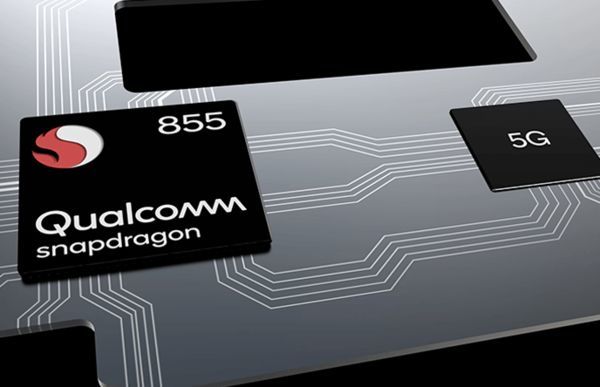
Qualcomm Announces New Flagship Snapdragon 855 Mobile Platform - A New Decade of 5G, AI, and XR
"World’s First Commercial 5G Mobile Platform is Sampling to Customers Now, and Expected to Support Premium Multi-Gigabit Smartphones in the first half of 2019 During the second day of the annual Snapdragon Technology Summit, Qualcomm Technologies, Inc., a subsidiary of Qualcomm Incorporated (NASDAQ:QCOM), unveiled the newest generation in the 8 Mobile Platform Series, the Qualcomm® Snapdragon™ 855 Mobile Platform. This is the world’s first commercial mobile platform supporting multi-gigabit 5G, industry-leading AI and immersive extended reality (XR) collectively, ushering in a new decade of revolutionary mobile devices. Using new chip architectures built on leading 7nm process technology, Snapdragon 855 will offer users long-lasting battery life and superior experiences in areas such as imaging, audio, gaming and XR. “As operators launch 5G networks in early 2019, consumers will for the first time be able to take advantage of transformative 5G consumer experiences on mobile devices with Snapdragon 855,” said Alex Katouzian, senior vice president and general manager, mobile, Qualcomm Technologies, Inc. “We are proud to share our technology inventions and be among the first to bring mobile 5G to the world.” Connectivity: The Snapdragon 855 Mobile Platform unleashes transformative 5G experiences to the world, with the Snapdragon X50 5G modem, while harnessing the best in multi-gigabit 4G connectivity with the built in Snapdragon X24 LTE modem. With Snapdragon X50, this platform supports 5G for both Sub-6 GHz and mmWave frequency bands, providing blazing-fast responsiveness and unprecedented speeds. It is designed to deliver Multi-Gigabit speeds that were previously unachievable in mobile communication." [...]

Rugged Micropower Magnetic Sensor ICs Maximize Battery Life, Improve System Efficiency
"Allegro MicroSystems has announced the release of a family of Micropower Hall-effect switch ICs—the APS11700 and APS11760—designed specifically for battery powered applications in harsh industrial and automotive environments. Automatic power management enables average supply current as low as 6µA while operating directly from a vehicle battery or other unregulated supply. The power management happens in the background and is transparent to the host system, making them a drop-in upgrade for existing Hall-effect switches or a solid-state replacement for mechanical microswitches or reed switches. "Thanks to the APS11700/760’s unique combination of ruggedness and ultra-low power, there is finally a reliable, solid-state upgrade for reed and microswitches, even in the most power-sensitive applications where the sensor will be connected directly to the battery," explains Jim Judkins, Product Line Director for Allegro's Position Sensor ICs. These monolithic devices include either a standard Hall plate or a vertical Hall plate, a small-signal amplifier, chopper stabilization, a Schmitt trigger, automatic power management controller, and an NMOS output transistor. The APS11700 uses a standard planar Hall-effect sensing element, while the APS11760 implements AVHT technology in the form of a silicon-based vertical Hall-effect sensing element." [...]

NVIDIA Extends PhysX for High-Fidelity Simulations, Goes Open Source
"NVIDIA PhysX, the most popular physics simulation engine on the planet, is going open source. We’re doing this because physics simulation — long key to immersive games and entertainment — turns out to be more important than we ever thought. Physics simulation dovetails with AI, robotics and computer vision, self-driving vehicles, and high performance computing. It’s foundational for so many different things that we’ve decided to provide it to the world in an open source fashion. Meanwhile, we’re building on more than a decade of continuous investment in this area to simulate the world with ever greater fidelity, with ongoing research and development to meet the needs of those working in robotics and with autonomous vehicles. Free, Open-Source, GPU-Accelerated PhysX will now be the only free, open-source physics solution that takes advantage of GPU acceleration and can handle large virtual environments." [...]

2 kids get artificial limbs using 3D printing facility at Kasturba Hospital
"Two children with deformities have received artificial limb printed (manufactured) at “ Hastha” Department of Orthopaedics, Kasturba Hospital, Manipal. The revolutionary 3D printing facility for artificial limb manufacturing at “Hastha” was inaugurated by Dr. H. Vinod Bhat, Vice Chancellor, MAHE, Manipal recently. “Hastha”the Centre for Congenital Hand Differences has been established under Manipal Academy of Higher Education through the unit of Hand and Microsurgery, Department of Orthopaedics, Kasturba Medical College and Hospital, Manipal. The Chief Co-ordinator for this Centre is Dr. Anil K. Bhat, Prof and Head, Department of Orthopaedics, Manipal. According to Dr Avinash Shetty, Medical Superintendent, Kastuba Hospital said 3D printable prosthetics are the new revolution in manufacturing artificial limbs, especially for children in order to develop prosthesis that is innovative, customizable and cheap. It can be replaced often without incurring much cost." [...]

The Microsoft Simple Encrypted Arithmetic Library goes open source
"Today we are extremely excited to announce that our Microsoft Simple Encrypted Arithmetic Library (Microsoft SEAL), an easy-to-use homomorphic encryption library developed by researchers in the Cryptography Research group at Microsoft, is open source on GitHub under an MIT License for free use. The library has already been adopted by Intel to implement the underlying cryptography functions in HE-Transformer, the homomorphic encryption back end to its neural network compiler nGraph. As we increasingly move our data to the cloud, there is a clear concern that arises: How can we balance convenience and privacy? We all love to get practical guidance on how to, for example, maximize our investments, improve our workouts, or reach our destinations as efficiently as possible. In exchange, we share personal information with service providers because we have few other options. With traditional encryption schemes, it is impossible to run any computation on encrypted data." [...]

NASA Announces New Partnerships for Commercial Lunar Payload Delivery Services
"Nine U.S. companies now are eligible to bid on NASA delivery services to the lunar surface through Commercial Lunar Payload Services (CLPS) contracts, as one of the first steps toward long-term scientific study and human exploration of the Moon and eventually Mars. These companies will be able to bid on delivering science and technology payloads for NASA, including payload integration and operations, launching from Earth and landing on the surface of the Moon. NASA expects to be one of many customers that will use these commercial landing services. “Today’s announcement marks tangible progress in America’s return to the Moon’s surface to stay,” said NASA Administrator Jim Bridenstine. “The innovation of America’s aerospace companies, wedded with our big goals in science and human exploration, are going to help us achieve amazing things on the Moon and feed forward to Mars.” The selected companies are: Astrobotic Technology, Inc.: Pittsburgh Deep Space Systems: Littleton, Colorado Draper: Cambridge, Massachusetts Firefly Aerospace, Inc.: Cedar Park, Texas Intuitive Machines, LLC: Houston Lockheed Martin Space: Littleton, Colorado Masten Space Systems, Inc.: Mojave, California Moon Express: Cape Canaveral, Florida Orbit Beyond: Edison, New Jersey NASA’s Science Mission Directorate (SMD) initiated the request for proposals leading to these selections as the first step in achieving a variety of science and technology objectives that could be addressed by regularly sending instruments, experiments and other small payloads to the Moon. SMD serves as the NASA interface between the agency’s mission directorates, the scientific community, and other external stakeholders in developing a strategy to enable an integrated approach for robotic and human exploration within NASA’s Moon to Mars Exploration Campaign." [...]
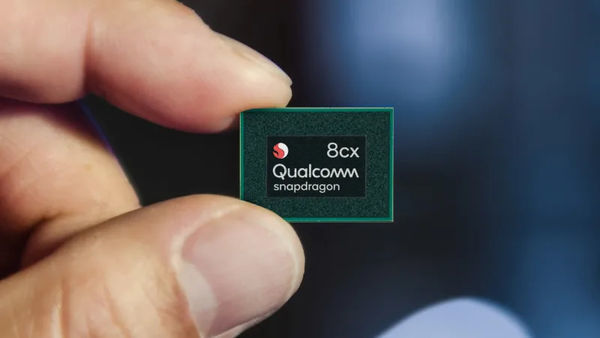
Qualcomm Introduces the World's First 7 Nanometer PC Platform
"Designed from the Ground up for the Next Generation of Computing Experiences, the Qualcomm Snapdragon 8cx is the Most Extreme Snapdragon Ever, Bringing Breakthrough Innovations to PC Design During the third day of the annual Snapdragon Technology Summit, Qualcomm Technologies, Inc., a subsidiary of Qualcomm Incorporated (NASDAQ: QCOM), unveiled the Qualcomm® Snapdragon™ 8cx Compute Platform, the world’s first 7 nanometer PC platform. Created from the ground up for the next generation of personal computing by bringing new features with thin and light designs, allowing for new form factors in the always-on, always-connected category, the Snapdragon 8cx packs the new Qualcomm ® Adreno™ 680 GPU, the most powerful GPU ever designed by Qualcomm Technologies, Inc. Doubling the memory interface from 64 bit to 128 bit wide, and with greater performance than previous Snapdragon compute platforms, consumers will benefit from enhanced experiences and cutting-edge graphics when creating and consuming content. The Snapdragon 8cx is currently sampling to customers and is expected to begin shipping in commercial devices in Q3 of 2019. “With performance and battery life as our design tenets, we’re bringing 7nm innovations to the PC space, allowing for smartphone-like capabilities to transform the computing experience,” said Alex Katouzian, senior vice president and general manager of mobile for Qualcomm Technologies. “As the fastest Snapdragon platform ever, the Snapdragon 8cx will allow our customers to offer a powerful computing experience of multi-day battery life and multi-gigabit connectivity, in new thin, light and fanless design for consumers and the enterprise.” The Snapdragon 8cx features the new octa-core Qualcomm® Kryo™ 495 CPU, the fastest Kryo CPU ever designed and built by Qualcomm Technologies, Inc. With a larger cache than previous compute platforms, the Kryo 495 allows for faster multi-tasking and increased productivity for users, disrupting the performance expectations of current thin, light and fanless PC designs." [...]

Industry's First RISC-V SoC FPGA Architecture Brings Real-Time to Linux, Giving Developers the Freedom to Innovate in Low-Power, Secure and Reliable Designs
"RISC-V Summit - In a new era of computing driven by the convergence of 5G, machine learning and the internet of things (IoT), embedded developers need the richness of Linux-based operating systems. These must meet deterministic system requirements in ever lower power, thermally constrained design environments—all while addressing critical security and reliability requirements. Traditional system-on-chip (SoC) field programmable gate arrays (FPGAs) blending reconfigurable hardware with Linux-capable processing on a single chip provide developers ideal devices for customization, yet consume too much power, lack proven levels of security and reliability, or use inflexible and expensive processing architectures. In response, Microchip Technology Inc. (Nasdaq: MCHP), via its Microsemi Corporation subsidiary, today extended its Mi-V ecosystem by unveiling the architecture for a new class of SoC FPGAs that combine the industry's lowest power mid-range PolarFire™ FPGA family with a complete microprocessor subsystem based on the open, royalty-free RISC-V instruction set architecture (ISA). Announced today at the RISC-V Summit in Santa Clara, California, Microchip's new PolarFire SoC architecture brings real-time deterministic asymmetric multiprocessing (AMP) capability to Linux platforms in a multi-core coherent central processing unit (CPU) cluster. The PolarFire SoC architecture, developed in collaboration with SiFive, features a flexible 2 MB L2 memory subsystem that can be configured as a cache, scratchpad or a direct access memory." [...]
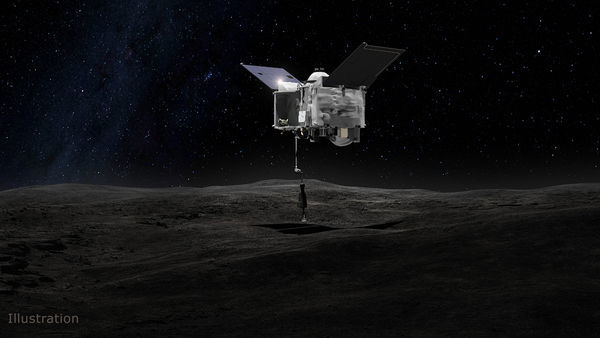
Planetary Defense: The Bennu Experiment
"On Dec. 3, after traveling billions of kilometers from Earth, NASA's OSIRIS-REx spacecraft reached its target, Bennu, and kicked off a nearly two-year, up-close investigation of the asteroid. It will inspect nearly every square inch of this ancient clump of rubble left over from the formation of our solar system. Ultimately, the spacecraft will pick up a sample of pebbles and dust from Bennu's surface and deliver it to Earth in 2023. Generations of planetary scientists will get to study pieces of the primitive materials that formed our cosmic neighborhood and to better understand the role asteroids may have played in delivering life-forming compounds to planets and moons. But it's not just history that the mission to Bennu will help uncover. Scientists studying the rock through OSIRIS-REx's instruments in space will also shape our future." [...]
Ciência e Tecnologia

Reproducing paintings that make an impression
"CSAIL's new RePaint system aims to faithfully recreate your favorite paintings using deep learning and 3-D printing. The empty frames hanging inside the Isabella Stewart Gardner Museum serve as a tangible reminder of the world’s biggest unsolved art heist. While the original masterpieces may never be recovered, a team from MIT’s Computer Science and Artificial Intelligence Laboratory (CSAIL) might be able to help, with a new system aimed at designing reproductions of paintings. RePaint uses a combination of 3-D printing and deep learning to authentically recreate favorite paintings — regardless of different lighting conditions or placement. RePaint could be used to remake artwork for a home, protect originals from wear and tear in museums, or even help companies create prints and postcards of historical pieces. “If you just reproduce the color of a painting as it looks in the gallery, it might look different in your home,” says Changil Kim, one of the authors on a new paper about the system, which will be presented at ACM SIGGRAPH Asia in December." [...]
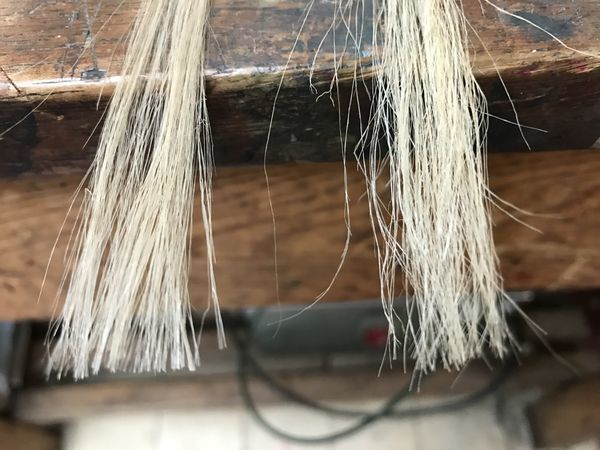
Adding graphene to jute fibres could give natural alternative to man-made materials
"Scientists from The University of Manchester have combined graphene with the natural fibre, jute, to create a world’s first for graphene-strengthened natural jute fibre composites. The breakthrough could lead to the manufacturing of high-performance and environmentally friendly natural fibre composites that could replace their synthetic counterparts in major manufacturing areas, such as the automotive industry, ship building, durable wind turbine blades and low-cost housing. It could also boost the farming economies of countries such as Bangladesh, India, and China – where the jute material is mainly produced – the researchers from The University of Manchester claim. The University is home to the National Graphene Institute and the Graphene Engineering Innovation Centre which provide an unrivalled critical mass of graphene expertise. The two facilities demonstrate Manchester's position as a globally leading knowledge-base in graphene research and commercialisation. Jute is extracted from the bark of the white jute plant (Corchorus capsularis) and is a 100% bio-degradable, recyclable and environmentally friendly natural fibre." [...]
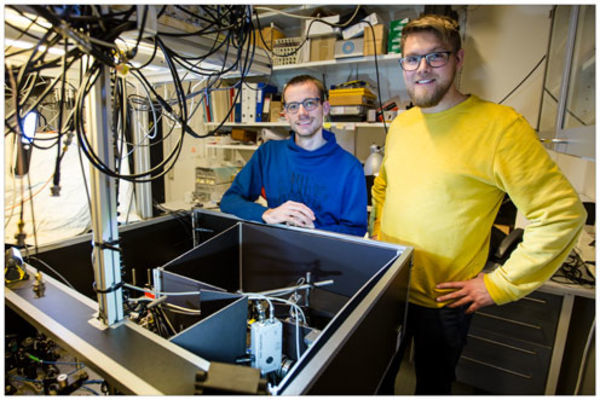
An important step towards completely secure quantum communication networks
"The quest for a secure information network is on. Researchers at the Niels Bohr Institute, University of Copenhagen, have recently succeeded in boosting the storage time of quantum information, using a small glass container filled with room temperature atoms, taking an important step towards a secure quantum encoded distribution network. Sending information in optical fibres over long distances in the classical regime Sending information over long distances can be done by encoding messages into light pulses, and sending them through optical fibres. But there is loss in fibres, so amplification is necessary along the way. Repeaters amplify the light pulses at specific intervals along the line and Voila! – transatlantic communication is possible." [...]

USC scientists find a way to enhance quantum computer performance
"USC scientists have demonstrated a theoretical method to enhance the performance of quantum computers, an important step to scale a technology with potential to solve some of society’s biggest challenges. The method addresses a weakness that bedevils performance of the next-generation computers by suppressing erroneous calculations while increasing fidelity of results, a critical step before the machines can outperform classic computers as intended. Called “dynamical decoupling,” it worked on two quantum computers, proved easier and more reliable than other remedies and could be accessed via the cloud, which is a first for dynamical decoupling The technique administers staccato bursts of tiny, focused energy pulses to offset ambient disturbances that muck sensitive computations. The researchers report they were able to sustain a quantum state up to three times longer than would otherwise occur in an uncontrolled state. “This is a step forward,” said Daniel Lidar, a professor of electrical engineering, chemistry and physics at USC and director of the USC Center for Quantum Information Science and Technology. “Without error suppression, there’s no way quantum computing can overtake classical computing." [...]
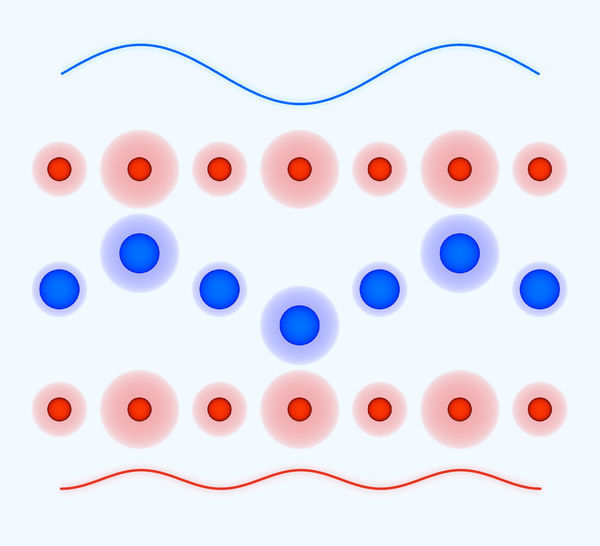
Terahertz laser pulses amplify optical phonons in solids
"A study led by scientists of the Max Planck Institute for the Structure and Dynamics of Matter (MPSD) at CFEL presents evidence of the amplification of optical phonons in a solid by intense terahertz laser pulses. These light bursts excite atomic vibrations to very large amplitudes, where their response to the driving electric field becomes nonlinear and conventional description fails to predict their behavior. In this new realm, fundamental material properties usually considered constant are modulated in time and act as a source for phonon amplification. The scientists report their findings in the PNAS. The amplification of light dramatically changed science and technology in the 20th century. This path, which began in 1960 with the invention of the laser, still has such a remarkable impact that the 2018 Nobel Prize in Physics was awarded “for groundbreaking inventions in the field of laser physics”." [...]

Automated technique for anime colorization using deep learning
"Japanese researchers from IMAGICA GROUP Inc., OLM Digital, Inc. and Nara Institute of Science and Technology (NAIST) have jointly developed a technique for automatic colorization in anime production. While the number of animation works produced in Japan has been increasing every year, the number of animators has remained almost unchanged. To promote efficiency and automation in anime production, the research team focused on the possibility of automating the colorization of trace images in the finishing process of anime production. By integrating the anime production technology and know-how of IMAGICA GROUP Inc. and OLM Digital, Inc. with the machine learning, computer graphics and vision technology of NAIST, the research team succeeded in developing the world's first technique for automatic colorization of Japanese anime production. The technique is based on recent advances of deep learning approaches that are nowadays widely applied in various fields. After the trace image cleaning in a pre-processing step, automatic colorization is performed according to the color script of the character using a deep learning-based image segmentation algorithm." [...]
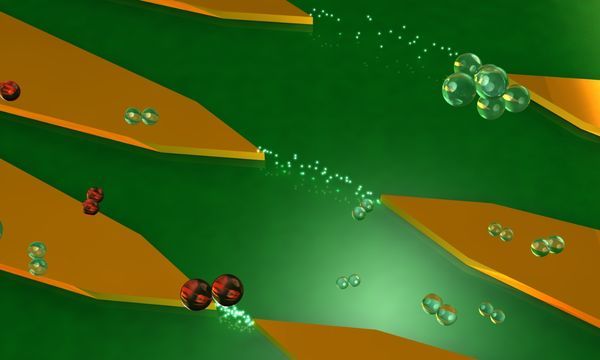
Solution for next generation nanochips comes out of thin air
"The secret ingredient for the next generation of more powerful electronics could be air, according to new research. Researchers at RMIT University have engineered a new type of transistor, the building block for all electronics. Instead of sending electrical currents through silicon, these transistors send electrons through narrow air gaps, where they can travel unimpeded as if in space. The device unveiled in material sciences journal Nano Letters, eliminates the use of any semiconductor at all, making it faster and less prone to heating up. Lead author and PhD candidate in RMIT’s Functional Materials and Microsystems Research Group, Ms Shruti Nirantar, said this promising proof-of-concept design for nanochips as a combination of metal and air gapscould revolutionise electronics. “Every computer and phone has millions to billions of electronic transistors made from silicon, but this technology is reaching its physical limits where the silicon atoms get in the way of the current flow, limiting speed and causing heat,” Nirantar said." [...]
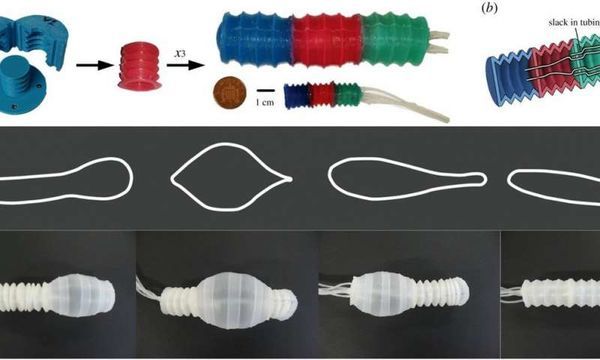
EuMoBot: Replicating euglenoid movement in a soft robot
"Swimming is a form of locomotion employed by many organisms across a wide range of scales in nature. Microorganisms with small mass that encounter dominance of viscous forces in the medium require a change in shape that does not vary with time to achieve fluidic propulsion aligned with hydrodynamics. To overcome this challenge, unicellular flagellates of the Euglena family evolved a characteristic movement known as 'euglenoid movement' in which the body significantly changes shape, allowing the organism to navigate through viscous fluids and tiny spaces. This ability to change the body shape and move through constrained spaces and cluttered environments is particularly attractive in engineering biomimetic robots. Example applications of miniature robots include movement through biological fluids during medical procedures in vivo and navigating through rubble in external environments during search and rescue operations of survivors. Inspired by euglenoids, Krishna Manaswi Digumarti and co-workers at the Department of Engineering and Mathematics presented the design and development of EuMoBot, a multi-segmented soft robot." [...]
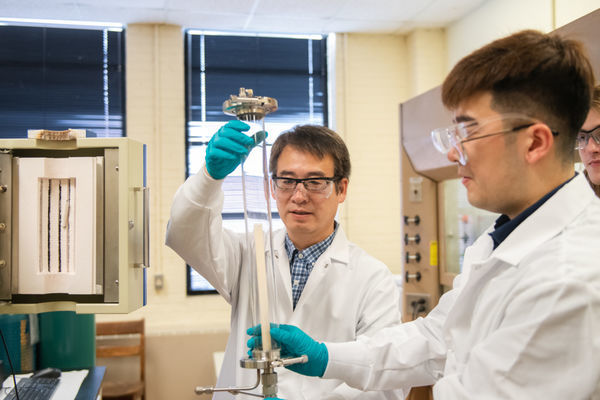
Lasers could take 3D printing to next level at Clemson University
"Cars that go more than 1,000 miles on a single fill-up and smartphones that can run for days without recharging are among the possibilities that could come out of a new Clemson University research project that brings together 3D printing and laser processing. Jianhua “Joshua” Tong and his team are working on a new 3D-printing technique involving rapid laser processing to create “protonic ceramic electrolyzer stacks” that convert electricity to hydrogen as a way of storing energy. The electrolyzers could have several uses, including as a fuel source in cars or to store energy generated from solar and wind power. The new laser 3D-printing technique would reduce the cost and time of manufacturing highly compacted electrolyzers, Tong said. In doing so, it could not only cut the cost of hydrogen production in half but also decrease device size one order of magnitude, he said. Tong, an associate professor of materials science and engineering, is leading the research with $1.6 million from the U.S. Department of Energy’s Office of Energy Efficiency and Renewable Energy." [...]

Sculpting light for new technologies
"On a dime-sized structure, researchers at INRS and the University of Sussex have created an optical device that uses artificial intelligence to control the properties of light. Many technologies, including biomedical imaging systems, rely on lasers to produce light that has properties tailored to a particular application. Optical systems make it possible to shape and control the characteristics of laser light, but with certain limitations for the user. Today, researchers are able to miniaturize optical tools and assemble them on what is known as an optical chip. No bigger than a fingertip, optical chips are like an obstacle course for the light that passes through them, changing its properties in the process. Improvements in optical chip design, as unveiled by Professor Roberto Morandotti and an international research team in a recently published article in Nature Communications, open the door to a wealth of new scientific and technological possibilities." [...]

Atomic nitrogen route to new 2D semiconductors
"A technique for making ultrathin, two-dimensional films of tungsten disulfide could underpin next-generation electronic and optoelectronic technologies. A simple and non-destructive fabrication technique could aid the manufacture of more energy efficient two-dimensional (2D) films needed to transform the electronics industry. Atomically thin, 2D transition metal dichalcogenides (TMDCs) like tungsten disulfide (WS2) exhibit remarkable physical, electronic and optoelectronic properties, such as flexibility, transparency and semi-conducting characteristics. Although there has been significant progress in fabricating 2D TMDCs, the ultrathin nature of such 2D semiconductors precludes the usage of techniques like ion implantation, with subsequent activation annealing, for introducing and retaining dopants within mono- or few-layer TMDCs. Now, Dongzhi Chi and colleagues from the Institute of Materials Research and Engineering and the Institute of High Performance Computing at A*STAR, in collaboration with researchers from the National University of Singapore, have developed an innovative technique that uses highly reactive nitrogen (N) atoms for controlling dopants within films of WS2 at the atomic scale, and promises a reliable method for doping 2D TMDCs. “[The current] inability to effectively dope 2D TMDCs hinders developing energy efficient devices like field-effect transistors using manufacturing technologies currently employed in the semiconductor industry,” says Chi." [...]

Best hope yet for aluminium-ion batteries
"UNSW Sydney’s Dr Dong Jun Kim has led a team of researchers to show rechargeable aluminium-ion batteries are a possibility with a future in renewable energy storage. Aluminium-ion batteries are a step closer to becoming a reality after a UNSW Sydney chemist found a way to make the science behind the technology work. In a study completed at Northwestern University in Illinois and published today in Nature Energy, Dr Dong Jun Kim – now of UNSW’s School of Chemistry – led a team of researchers including Nobel Laureate Sir Fraser Stoddart to demonstrate a strategy for designing active materials for rechargeable aluminium batteries. Up until now, finding appropriate host electrodes for insertion of complex aluminium ions had been a fundamental challenge. “We found a novel way to design rechargeable aluminium batteries by employing a redox-active macrocyclic compound as the active material,” Dr Kim said. In other words, Dr Kim and his team managed to use a large organic chemical compound as the part of the battery that stores energy, something that previously had researchers stumped." [...]
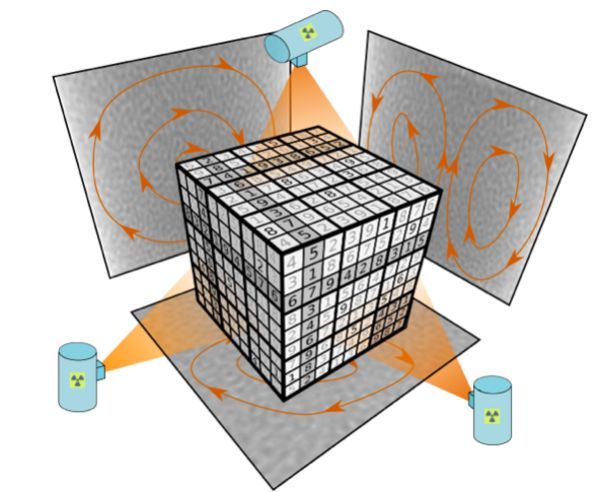
"Sudoku" x-ray uncovers movements within opaque materials
"New method based on popular puzzle allows scientists to see flowing grains. University of Sydney researchers have developed a new x-ray method which involves solving a giant, three dimensional sudoku problem to better understand these granular movements - and the findings could have a big impact on numerous industries. When strolling along the beach, our footprints tell us that the sand under the surface must have moved but not precisely where or how. Similar movements occur in many other natural and man-made substances, such as snow, construction materials, pharmaceutical powders, and even cereals. To examine these largely unknown granular movements, academics from the Sydney Centre in Geomechanics and Mining Materials (SciGEM), including Professor of Civil Engineering Itai Einav and Postdoctoral Research Associate Dr James Baker, have developed a new x-ray method, which allows scientists to see inside granular flows. Named x-ray rheography, or “writing flow”, their approach gathers information using 3-point high-speed radiography, and then assembles this information by solving a Sudoku-style puzzle." [...]
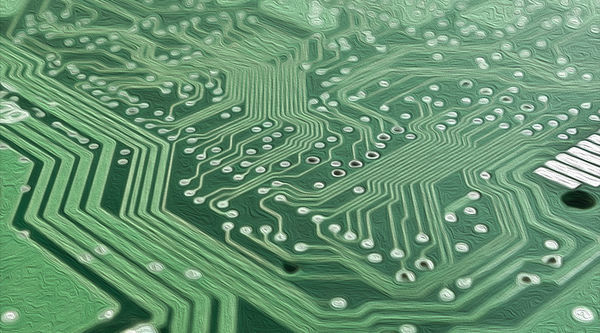
A new light on significantly faster computer memory devices
"In an article published online today in Science Advances, a team of scientists from Arizona State University's School of Molecular Sciences and Germany offer an explanation of how a particular phase-change memory (PCM) material can work a thousand times faster than current flash computer memory, while being significantly more durable with respect to the number of daily read-writes. PCMs are a form of computer random-access memory (RAM) that store data by altering the state of the matter of the “bits” (millions of which make up the device) between liquid, glass and crystal states. PCM technology has the potential to provide inexpensive, high-speed, high-density, high-volume, nonvolatile storage on an unprecedented scale. The basic idea and material were invented by Stanford Ovshinsky in 1975, but applications have lingered due to lack of clarity about how the material can execute the phase changes on such short time scales and technical problems related to controlling the changes with necessary precision. Now high tech companies like Samsung, IBM and Intel are racing to perfect it. The semimetallic material under current study is an alloy of germanium, antimony and tellurium in the ratio of 1:2:4." [...]

No more dirt and dust: Nanotechnology solution for photovoltaic systems
"An EU initiative has developed a robust, durable and low-cost self-cleaning coating. This new product will help improve solar energy generation efficiency. Photovoltaic (PV) systems, which harvest sustainable and clean energy from the sun, accumulate dirt or particles like dust, water and sand. This build-up leads to a reduction in the light energy reaching the solar cells and lowers their power output by up to 50 %, according to some studies. Therefore, it’s crucial to keep them clean. However, the process of regular cleaning and maintenance could be costly and also waste water." [...]

Graphene unlocks new potential for 'smart textiles'
"The quest to create affordable, durable and mass-produced ‘smart textiles’ has been given fresh impetus through the use of the wonder material Graphene. An international team of scientists, led by Professor Monica Craciun from the University of Exeter Engineering department, has pioneered a new technique to create fully electronic fibres that can be incorporated into the production of everyday clothing. Currently, wearable electronics are achieved by essentially gluing devices to fabrics, which can mean they are too rigid and susceptible to malfunctioning. The new research instead integrates the electronic devices into the fabric of the material, by coating electronic fibres with light-weight, durable components that will allow images to be shown directly on the fabric. The research team believe that the discovery could revolutionise the creation of wearable electronic devices for use in a range of every day applications, as well as health monitoring, such as heart rates and blood pressure, and medical diagnostics. The international collaborative research, which includes experts from the Centre for Graphene Science at the University of Exeter, the Universities of Aveiro and Lisbon in Portugal, and CenTexBel in Belgium, is published in the scientific journal Flexible Electronics." [...]
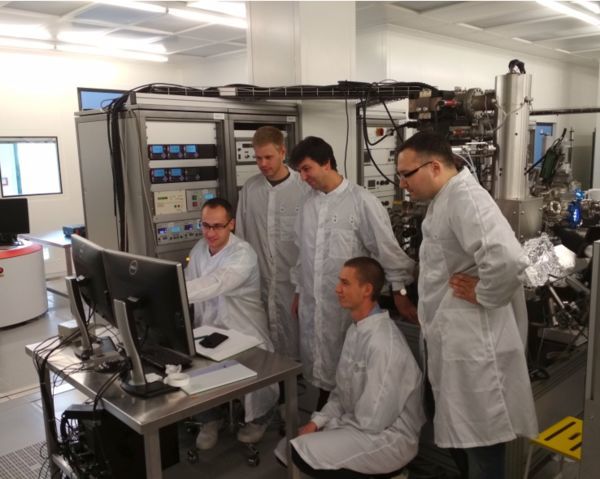
Scientists from CEITEC BUT introduced a way to control graphene properties
"In their recent publication the researchers from the group Molecular Nanostructures at Surfaces introduced a way to remotely control the properties of graphene by a low energy electron beam. The researchers of a recently established group at CEITEC BUT studied the influence of electron beam or X-rays on the properties of graphene. Their findings published in journal Nanoscale can be applied for example in adaptive electronics. According to its leader Jan Čechal, the recently established research group Molecular Nanostructures at Surfaces focuses on fabrication of structures with atomic or molecular precision. “In the classic approach the structures are fabricated by a lithographic structuring of the bulk material to create the intended design. That way, we are able to achieve precision below 10 nanometers." [...]
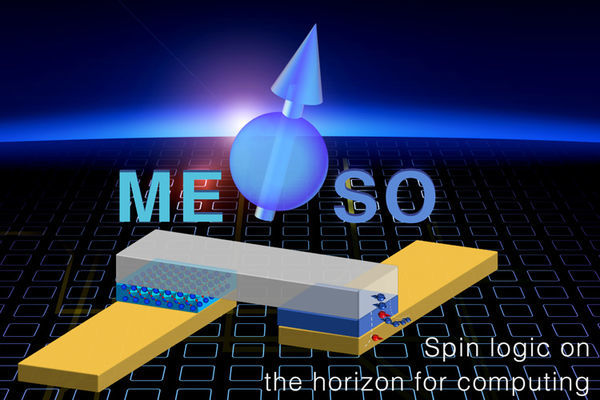
New quantum materials could take computers beyond the semiconductor era
"Researchers from Intel Corp. and UC Berkeley are looking beyond current transistor technology and preparing the way for a new type of memory and logic circuit that could someday be in every computer on the planet. In a paper appearing online Dec. 3 in advance of publication in the journal Nature, the researchers propose a way to turn relatively new types of materials, multiferroics and topological materials, into logic and memory devices that will be 10 to 100 times more energy-efficient than foreseeable improvements to current microprocessors, which are based on CMOS (complementary metal–oxide–semiconductor). The magneto-electric spin-orbit or MESO devices will also pack five times more logic operations into the same space than CMOS, continuing the trend toward more computations per unit area, a central tenet of Moore’s Law. The new devices will boost technologies that require intense computing power with low energy use, specifically highly automated, self-driving cars and drones, both of which require ever increasing numbers of computer operations per second. “As CMOS develops into its maturity, we will basically have very powerful technology options that see us through. In some ways, this could continue computing improvements for another whole generation of people,” said lead author Sasikanth Manipatruni, who leads hardware development for the MESO project at Intel’s Components Research group in Hillsboro, Oregon." [...]
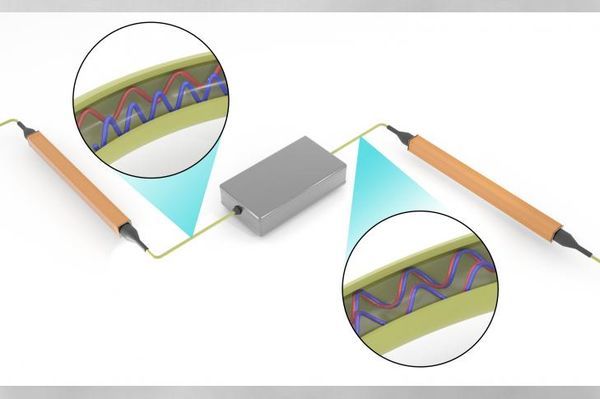
Researchers demonstrate new building block in quantum computing
"Researchers with the Department of Energy’s Oak Ridge National Laboratory have demonstrated a new level of control over photons encoded with quantum information. Their research was published in Optica. Joseph Lukens, Brian Williams, Nicholas Peters, and Pavel Lougovski, research scientists with ORNL’s Quantum Information Science Group, performed distinct, independent operations simultaneously on two qubits encoded on photons of different frequencies, a key capability in linear optical quantum computing. Qubits are the smallest unit of quantum information. Quantum scientists working with frequency-encoded qubits have been able to perform a single operation on two qubits in parallel, but that falls short for quantum computing. “To realize universal quantum computing, you need to be able to do different operations on different qubits at the same time, and that’s what we’ve done here,” Lougovski said." [...]

Will light be the basis for quantum computing?
"A team from INRS performs computing operations using highly complex quantum states—marking an important milestone in the development of quantum computing. Using a compact optical platform that exploits the quantum characteristics of light, Professor Roberto Morandotti and his team are one step closer to realizing the first powerful photonic quantum computer. In the journal Nature Physics, the INRS researchers revealed to have generated a particular class of quantum states–d-level cluster states–, as well as to have used them to implement novel quantum operations. The demonstrated states exhibit unique properties that make them more robust and powerful than any other such states demonstrated thus far. For nearly ten years, Professor Roberto Morandotti has been building an ambitious system piece by piece by developing chips that use light particles (photons) as the data medium. On these coin-sized chip structures, photons are generated and transformed so they can be assigned unique quantum properties." [...]
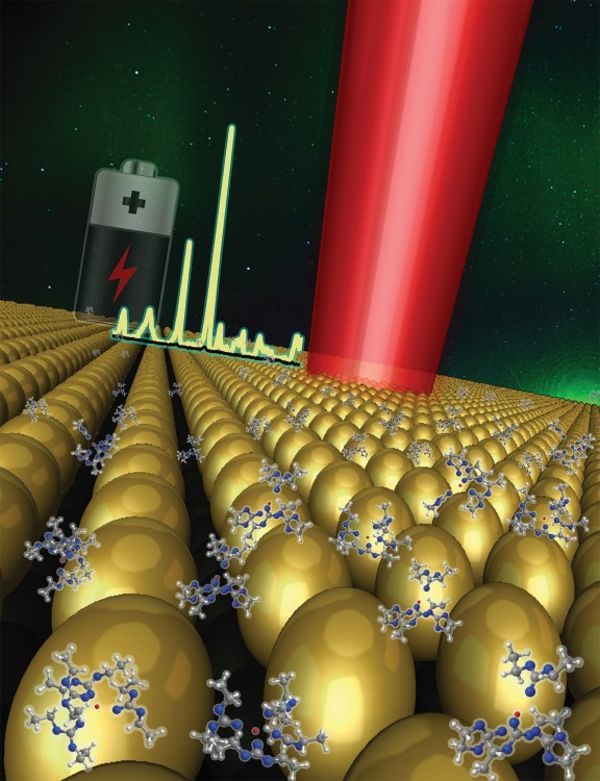
Batteries-Solid-liquid interface
"By studying the inner workings of lithium-ion batteries, Oak Ridge National Laboratory researchers have developed a highly sensitive technique to characterize and measure at the electrolyte and electrode interface. Their finding, published in ACS Nano, could help in understanding the fundamental factors that determine the composition and stability of solid electrolyte interphase, or SEI. “A robust SEI is key to the performance and safety of Li-ion batteries used to power electric vehicles,” said ORNL’s Jagjit Nanda. Li-ion batteries comprise positive and negative electrodes, each containing an electrolyte, or salt, solution, separated by a membrane. The researchers used surface enhanced Raman spectroscopy to evaluate how the lithium-salt interacts between the liquid electrolyte and electrode. “We found that the ion-solvation at the interface differs from what we observed in the bulk liquid electrolyte,” he said." [...]
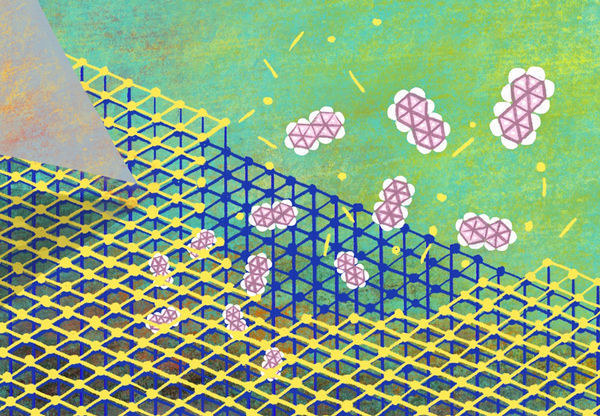
Capturing the surprising flexibility of crystal surfaces
"Real-time imaging has shown the surprising flexibility of a crystal surface upon guest molecule introduction, with implications for storage and sensing devices Images taken using an atomic force microscope have allowed researchers to observe, for the first time, the flexible and dynamic changes that occur on the surfaces of 'porous coordination polymer' crystals when guest molecules are introduced. The findings, published in the journal Nature Chemistry, have implications for investigations into materials that can be used for storing and sensing molecules. "We were surprised to find that the porous coordination polymer surface is exceptionally flexible and constantly fluctuating in solution," says Nobuhiko Hosono of Kyoto University's Institute for Integrated Cell-Material Sciences (iCeMS), "on the contrary to the common perception that the crystal is hard and immobile." Porous coordination polymers are crystalline materials that form by the self-assembly of metal ions and organic binding molecules called ligands. They are currently being investigated by materials scientists due to their ability to change their structure when other molecules are introduced to them or when they are exposed to certain external stimuli, without losing their crystallinity. This property makes them attractive for developing devices that can selectively adsorb gas molecules and thus filter or store them, such as storing hydrogen for energy." [...]
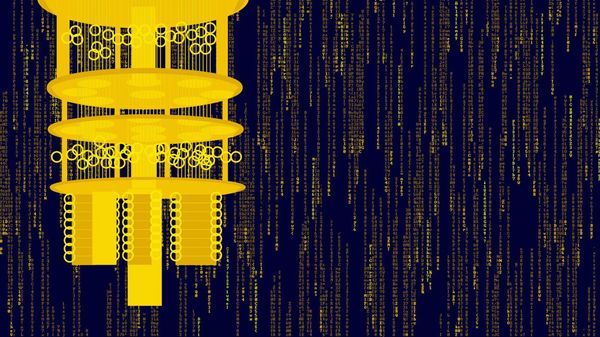
Quantum computers pose a security threat that we're still totally unprepared for
"Some US experts think it could take at least 20 years to get quantum-proof encryption widely deployed. The world relies on encryption to protect everything from credit card transactions to databases holding health records and other sensitive information. A new report from the US National Academies of Sciences, Engineering, and Medicine says we need to speed up preparations for the time when super-powerful quantum computers can crack conventional cryptographic defenses. Recommended for You 250 pages of internal Facebook files were just dumped online—here are the 6 key takeaways Data analysis could help locate the missing Malaysian MH370 plane Canada has arrested Huawei’s CFO for extradition to the US How to check if you’re affected by the Marriott mega data breach Despite CRISPR baby controversy, Harvard University will begin gene-editing sperm The experts who produced the report, which was released today, say widespread adoption of quantum-resistant cryptography “will be a long and difficult process” that “probably cannot be completed in less than 20 years.” It’s possible that highly capable quantum machines will appear before then, and if hackers get their hands on them, the result could be a security and privacy nightmare. Today’s cyberdefenses rely heavily on the fact that it would take even the most powerful classical supercomputers almost unimaginable amounts of time to unravel the cryptographic algorithms that protect our data, computer networks, and other digital systems. But computers that harness quantum bits, or qubits, promise to deliver exponential leaps in processing power that could break today’s best encryption." [...]

Focusing on the Negative is Good When it Comes to Batteries
"New concept based on fluoride ions may increase battery lifespans Imagine not having to charge your phone or laptop for weeks. That is the dream of researchers looking into alternative batteries that go beyond the current lithium-ion versions popular today. Now, in a new study appearing in the journal Science, chemists at several institutions, including Caltech and the Jet Propulsion Laboratory, which is managed by Caltech for NASA, as well as the Honda Research Institute and Lawrence Berkeley National Laboratory, have hit on a new way of making rechargeable batteries based on fluoride, the negatively charged form, or anion, of the element fluorine. "Fluoride batteries can have a higher energy density, which means that they may last longer—up to eight times longer than batteries in use today," says study co-author Robert Grubbs, Caltech's Victor and Elizabeth Atkins Professor of Chemistry and a winner of the 2005 Nobel Prize in Chemistry. "But fluoride can be challenging to work with, in particular because it's so corrosive and reactive." In the 1970s, researchers attempted to create rechargeable fluoride batteries using solid components, but solid-state batteries work only at high temperatures, making them impractical for everyday use." [...]
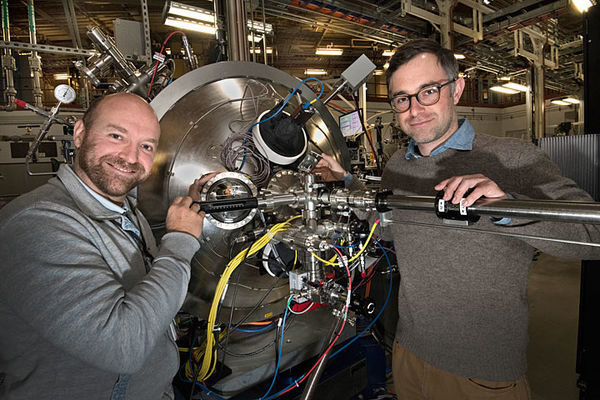
Reflecting Antiferromagnetic Arrangements
"An x-ray imaging technique developed at Brookhaven Lab's National Synchrotron Light Source II could help scientists understand—and ultimately control—the magnetic structure of promising materials for the development of electronic devices that exploit electron spin A team led by Rutgers University and including scientists from the U.S. Department of Energy’s (DOE) Brookhaven National Laboratory has demonstrated an x-ray imaging technique that could enable the development of smaller, faster, and more robust electronics. Described in a paper published on Nov. 27 in Nature Communications, the technique addresses a primary limitation in the emerging research field of “spintronics,” or spin electronics, using magnetic materials known as antiferromagnets (AFMs): the ability to image antiphase magnetic domains. Electrons in magnetic atoms point, or “spin,” in an up or down direction. In all magnetic materials, there are distinct regions—magnetic domains—in which the electron spins are arranged in a regular manner. Several configurations are possible depending on the type of magnetism. In AFMs, the spins on adjacent atoms point in opposite directions (e.g., up-down-up-down)." [...]
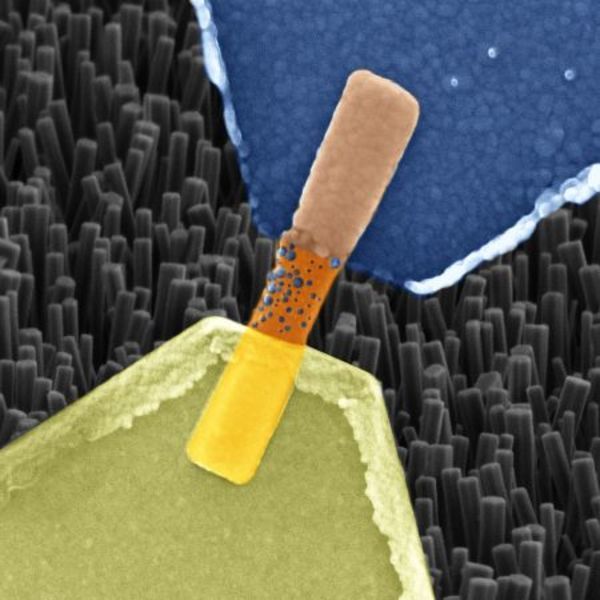
Artificial Synapses Made from Nanowires
"Scientists from Jülich together with colleagues from Aachen and Turin have produced a memristive element made from nanowires that functions in much the same way as a biological nerve cell. The component is able to both save and process information, as well as receive numerous signals in parallel. The resistive switching cell made from oxide crystal nanowires is thus proving to be the ideal candidate for use in building bioinspired “neuromorphic” processors, able to take over the diverse functions of biological synapses and neurons. Computers have learned a lot in recent years. Thanks to rapid progress in artificial intelligence they are now able to drive cars, translate texts, defeat world champions at chess, and much more besides. In doing so, one of the greatest challenges lies in the attempt to artificially reproduce the signal processing in the human brain." [...]
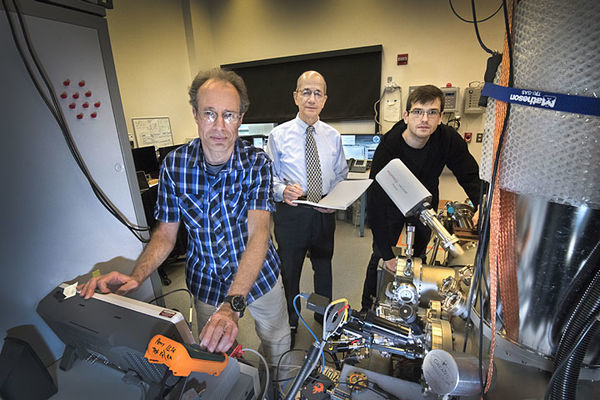
Borophene Advances as 2-D Materials Platform
"Atom-thin sheets of boron containing large single crystals could provide foundation for fabricating next-generation electronics. Borophene—two-dimensional (2-D) atom-thin-sheets of boron, a chemical element traditionally found in fiberglass insulation—is anything but boring. Though boron is a nonmetallic semiconductor in its bulk (3-D) form, it becomes a metallic conductor in 2-D. Borophene is extremely flexible, strong, and lightweight—even more so than its carbon-based analogue, graphene. These unique electronic and mechanical properties make borophene a promising material platform for next-generation electronic devices such as wearables, biomolecule sensors, light detectors, and quantum computers. Now, physicists from the U.S. Department of Energy’s (DOE) Brookhaven National Laboratory and Yale University have synthesized borophene on copper substrates with large-area (ranging in size from 10 to 100 micrometers) single-crystal domains (for reference, a strand of human hair is about 100 micrometers wide). Previously, only nanometer-size single-crystal flakes of borophene had been produced." [...]
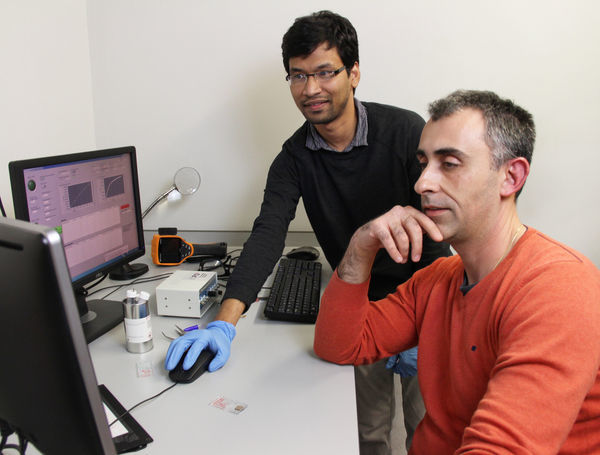
Colloidal Quantum Dots make LEDs shine bright in the Infrared
"ICFO researchers report on the development of a colloidal quantum-dot light emitting diode with unprecedented quantum and power conversion efficiencies in the infrared range. The ideal optoelectronic semiconductor material should be a strong light emitter i.e. should emit light very efficiently upon optical excitation as well as be an efficient charge conductor to allow for electrical injection in devices. These two conditions when met can lead to highly efficient light emitting diodes as well as to solar cells with the possibility to approach the Shockley-Queisser limit. Until now the materials that have come close to meeting these conditions have been based on epitaxially-grown costly III-V semiconductors that cannot be monolithically integrated to CMOS electronics. The ICFO team has reported a solution processed nanocomposite system comprising infrared colloidal quantum dots that also meets these criteria and at the same time offers low cost and facile CMOS integration." [...]
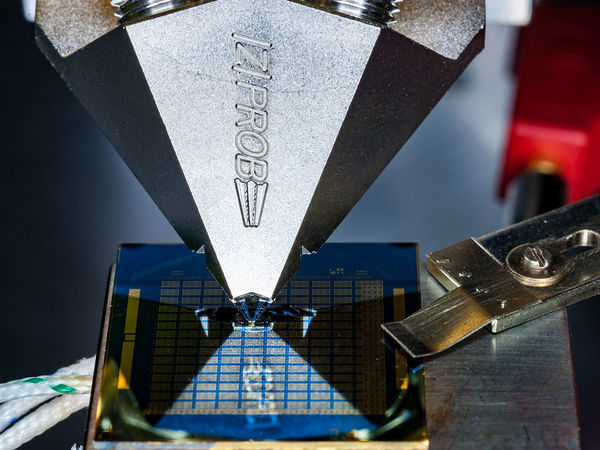
IBM Reveals 8-Bit Analog Chip With Phase-Change Memory
"Researchers used the chip to test a simple neural net and identify numerals with 100 percent accuracy Today at the IEEE International Electron Devices Meeting in San Francisco, IBM reported a new 8-bit analog chip. But the true development was less about analog chips catching up to their digital peers and more a radical rethink of chip architecture. This chip is the first to perform 8-bit calculations right where information is stored. In traditional von Neumann chip architecture, data constantly shuttles between memory and processing, which consumes valuable energy and time, says Abu Sebastian, the lead researcher on this work, from IBM Zurich. In-memory calculations are the logical next step for reducing power consumption while increasing performance. These gains are necessary for hardware to keep up with advancements in artificial intelligence." [...]
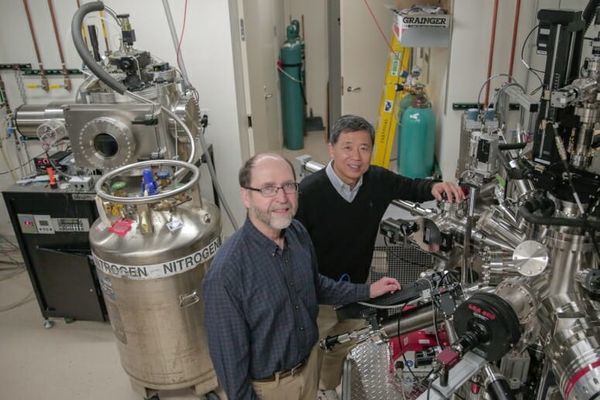
Switching identities: Revolutionary insulator-like material also conducts electricity
"University of Wisconsin–Madison researchers have made a material that can transition from an electricity-transmitting metal to a nonconducting insulating material without changing its atomic structure. “This is quite an exciting discovery,” says Chang-Beom Eom, professor of materials science and engineering. “We’ve found a new method of electronic switching.” The new material could lay the groundwork for ultrafast electronic devices, such as the cellphones and computers of the future. Eom and his international team of collaborators published details of their advance today (Nov. 29, 2018) in the journal Science. Metals like copper or silver conduct electricity, whereas insulators like rubber or glass do not allow current to flow. Some materials, however, can transition from insulating to conducting and back again." [...]

'Chemputer' promises app-controlled revolution for drug production
"A radical new method of producing drug molecules, which uses downloadable blueprints to easily and reliably synthesise organic chemicals via a programmable 'chemputer', could be set to democratise the pharmaceutical industry, scientists say. In a new paper published online in the journal Science, researchers from the University of Glasgow present for the first time how synthesis of important drug molecules can be achieved in an affordable and modular chemical-robot system they call a chemputer. While recent advances in chemical production have allowed some chemical compounds to be produced at laboratory scale via automated systems, the chemputer is underpinned by a new universal and interoperable standard for writing and sharing chemical recipes, developed by the University of Glasgow team. The key was to develop a general abstraction for chemistry that can be made universal, practical, and driven by a computer program. Those chemical recipes, run on a computer program the team calls the 'chempiler', instruct the chemputer how to produce molecules on-demand, more affordably and safely than ever possible before The researchers claim the ability to use a universal code will allow chemists all round the world to convert their recipe into digital code, allowing others to share and download recipes similar in a similar way to music is today on iTunes or Spotify. The chemputing approach was designed and developed by Professor Lee Cronin, the University of Glasgow's Regius Chair of Chemistry." [...]

Scientists uncover new properties of black holes
"New gravitational waves detections shed light on entire population of black holes. New detections and analysis of gravitational waves – announced Saturday, Dec. 1, at the Gravitational Wave Physics and Astronomy Workshop in College Park, Maryland – broaden scientists’ understanding of the entire population of stellar-mass black holes, which are formed from collapsing stars. The National Science Foundation’s LIGO (Laser Interferometer Gravitational-Wave Observatory) and the European-based Virgo gravitational wave detectors have now detected gravitational waves from a total of 10 stellar-mass binary black hole mergers and one merger of neutron stars, which are the dense, spherical remains of stellar explosions. Four additional detections provide LIGO Scientific and Virgo Collaboration (LVC) scientists a sufficient amount of data to infer properties that apply to all stellar black holes. Most notably, the Compact Binary Coalescence Rates and Populations subgroup, co-chaired by Northwestern University’s Chris Pankow, deduced that almost all stellar black holes weigh less than 45 times the mass of the sun. “Gravitational waves give us unprecedented insight into the population and properties of black holes,” said Pankow, who also is a postdoctoral fellow of Northwestern’s Center for Interdisciplinary Exploration and Research in Astrophysics (CIERA)." [...]
Modelos 3D
Com a disponibilidade de ferramentas que permitem dar azo a nossa imaginação na criação de peças 3D e espaços como o thingiverse para as publicar, esta rubrica apresenta alguns modelos selecionados que poderão ser úteis.

PCB Vice and mini cableholder
"This is a remix of the rubber band PCB vise by jasoncoon, which is a remix of the rubber band PCB vise by MS3FGX, which is a remix of the vise by Delph27.These parts are compatible with the original, except for the addition of a vertical cut which is a cableholder. " [...]
Projetos Maker
Diversos Projetos interessantes.

nRF52840 Development with Arduino and CircuitPython
"Introduction Whether you’re a novice programmer learning how to program or a seasoned expert looking for a quick rapid-prototyping development environment, Arduino and CircuitPython can be a great choice for programming environments/languages. Pairing those simple programming languages with a powerful microcontroller, like the nRF52840 takes them to an entirely new level – a level with Bluetooth capability! In this tutorial we’ll demonstrate how to equip your nRF52840 and development computer with the firmware and software required to develop in either Arduino or CircuitPython. Both of these languages support digital I/O in/out, analog inputs, serial buses, and, most key to the nRF52840, support for Bluetooth Low Energy (BLE). We’ll be mostly focusing on using these programming tools on the SparkFun Pro nRF52840 Mini, but any other nRF52840 should be adaptable. The only caveat is the Adafruit nRF52840 Bootloader should be installed on the nRF52840." [...]
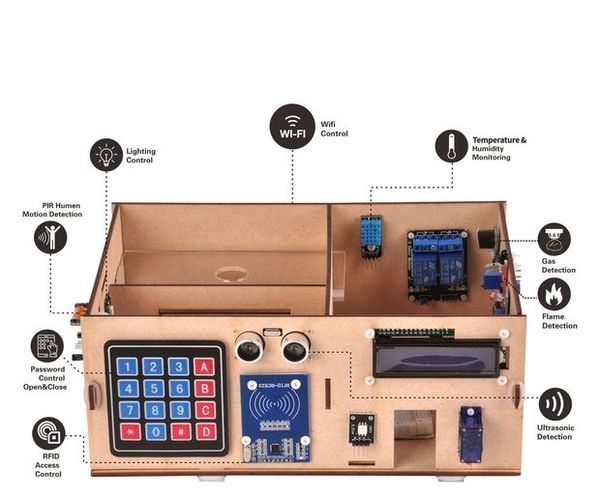
OSOYOO Yun IoT Smart Home Kit
"From controlling the room lights with your smart phone to scheduling events to occur automatically, home automation has taken convenience to a whole new level. Instead of using mechanical switches, you can now conveniently control all the devices in your home from your fingertips. Over here, we will show you how to implement a simple DIY home automation setup using an Arduino microcontroller development kit. In this Smart Home system, we constantly upload temperature and humidity, light intensity, gas values, flame value, RFID status values, human pyroelectric infrared sensor status values and other data to the Blynk platform at a certain time interval. With the controller options on the Blynk platform, you will be able to control your remote relay in real time. At the end of the setup, you will be able to turn any electrical appliance into a smart home device, and control it from your smart phone." [...]
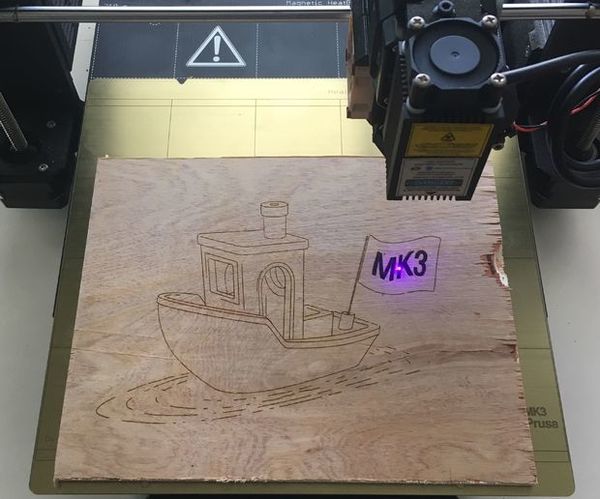
Laser Engraving on Your Prusa MK3
"Yes, your 3D printer is totally capable of making awesome laser engravings. Follow along to see how I did it. Hint: it's not complicated (well, probably just a manageable amount), and I created tools to make it easy for beginners and advanced skill levels to jump in and laser away. There are many steps and I included a lot of details. I want to be sure you understand why and how things are happening. Disclaimer: Lasers are very dangerous, so you need to use proper care and basic common sense to not get in trouble." [...]
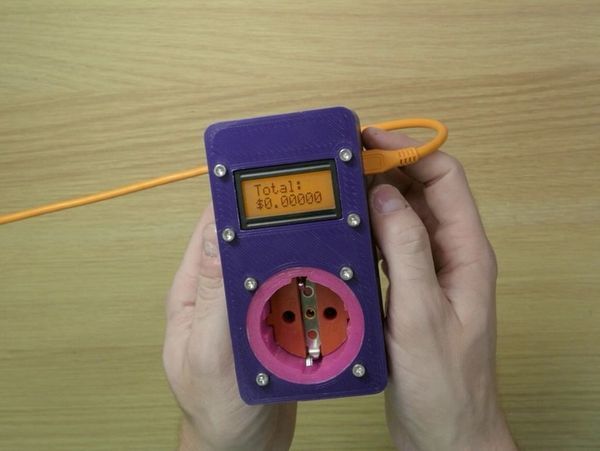
Arduino Energy Cost Electrical Meter Device
"Do you pay too much for your electricity bills? Do you want to know how much electricity your kettle or heater consumes? Make your own portable Energy Cost Electrical Meter! Watch how I found the use of this device. You need several things to make this project. Home computer with XOD IDE installed." [...]
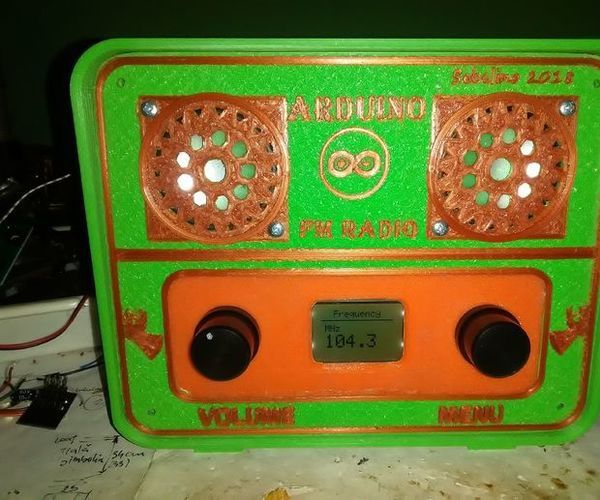
Arduino Fm Radio And Wi-Fi Thermometer
"How to build an FM radio (88-108 MHz) that also displays the outside temperature received from an emitter using the nrf24l01 module at the 2.4GHz frequency. The menu is intuitive and works with a rotary encoder. Choose from the menu what interests you !!! Good luck! 1.Radio frequency 2.Audio volume 3.Temperature 4.Display contrast 5.The back light" [...]

Arduinoflake
"A freeform interactive snowflake animated by Arduino Nano. Using 17 independent PWM channels and touch sensor it can create awesome effects! The snowflake consists of 30 LEDs grouped into 17 independent segments which can be controlled separately by Arduino Nano microcontroller. Each of the LED group can be dimmed with PWM to create some lovely animations. " [...]

CircuitPython on Linux and Raspberry Pi
"Here at Adafruit we're always looking for ways to make making easier - whether that's making breakout boards for hard-to-solder sensors or writing libraries to simplify motor control. Our new favorite way to program is CircuitPython. Why CircuitPython? CircuitPython is a variant of MicroPython, a very small version of Python that can fit on a microcontroller. Python is the fastest-growing programming language. It's taught in schools, used in coding bootcamps, popular with scientists and of course programmers at companies use it a lot!" [...]
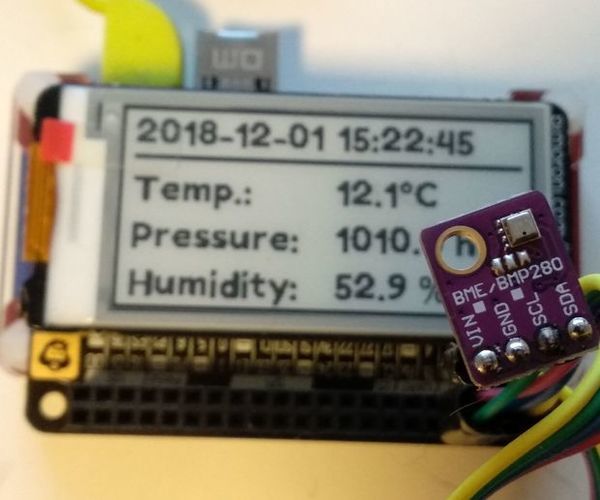
Inky_pHAT Weather Station
"I here would like to describe a very simple and compact, Raspberry Pi Zero-based weather station, which displays the values measured by a BME280 temperature/pressure/humidity sensor on a Pimoroni Inky pHAT e-paper/e-ink display. To allow the connection of sensors and the pHAT to the GPIO of the Pi I placed a Pimorini Pico HAT hacker with two female headers attached between the GPIO and the display. The device has been used to attach several sensors, so the BME280 version described here is just an example. Unlike LCD displays, e-ink displays keep the image even if power has been switched off. Therefore they are a very good solution if you want to display information that is updated just from time to time, especially to build low energy devices. The major benefit of the monochrome/black version of the Inky pHAT is that updating the display takes just about one second, instead of ten to fifteen seconds required by the three-color versions." [...]

Ni-MH Battery Charger
"Every one heard about SMPS. But how many know about its working?? SMPS is a wonder for me. So I am search much more about it. Now I know little bit about it. Here I am trying to introduce a small basic SMPS circuit." [...]
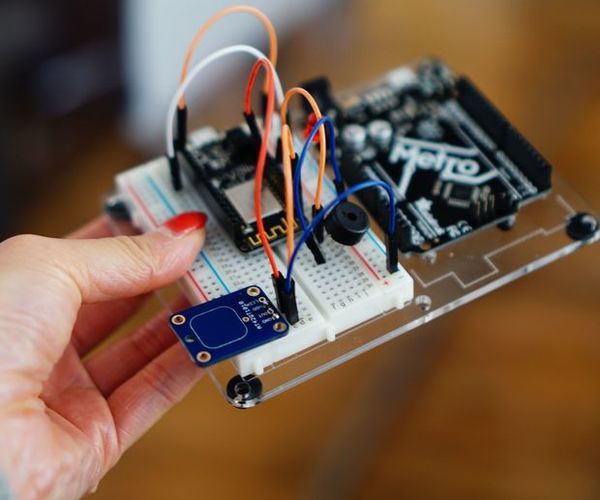
Hey Pillow IoT Alarm
"Know someone that constantly struggle to get out of bed, comes late to work and you are just want to give them a nudge in the morning. Now you can make your own Hey Pillow. Inside the pillow is embedded with an annoying piezo buzzer that you can control via your phone, so that you can unleash it where ever and whenever you want with the Arduino ESP8266 hardware. " [...]

Robotic E-textile
"Hello! My name is Fiberbot, and I am so happy you are going to be making more of my friends. In this instructables you will learn exactly how to make a robot that looks just like me. I will also let you in on a little secret and share with you how to make me smile (aka, how to code me!) Because I've been teaching lots of people how to make more Fiberbots, I am very tired and could really use a nap. So, instead of me teaching it will be my owner who always knows how to put a smile on my face...literally." [...]

Make a Shopvac and Cyclone Shop Cart
"For most of us there is always a constant battle to reduce wasted shop floor space. To me thats one piece of motivation for getting this project done. Ive got a 12 gallon shopvac hooked up to a cyclone dust separator and moving them around the shop together is a pain in the butt. Thats motivating factor #2. Ive also got a bunch of hoses and accessories taking up floor space in a separate box on the shop floor. More motivation." [...]
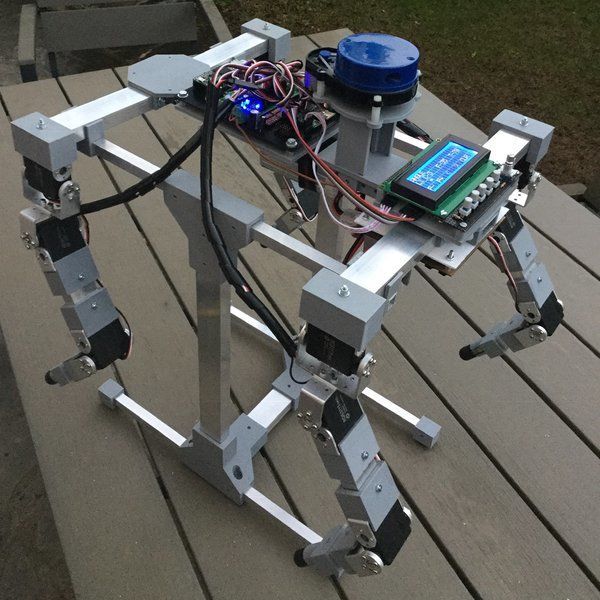
RAP an autonomous quadruped robot
"RAP is aimed at developing from scratch - ie no ROS - the HW and SW of a four-leg robot with sensors enabling an autonomous walk. This project started from my desire to develop an autonomous robot without relying on existing kits, so I could dig into the necessary algorithms, hardware design and associated code. I initially considered developing on top of ROS (Robot Operating System) but as this is my first project of this kind, I decided to stay "bare metal" - I am not a Linux expert - and become familiar with Inverse Kinematics, COG determination etc. RAP stands for Robotic Autonomous Pet - which certainly sounds much more serious than what this project actually is ! - and has the following characteristics : - four leg, 3 DOF per leg - sensors : LIDAR for 2D scan of the environment, IMU to get pitch, roll, yaw and compass information, Foot pressure sensors for detecting "in the air leg" situations. - Wifi connectivity Hardware design was done on Fusion360, all code done in C++." [...]
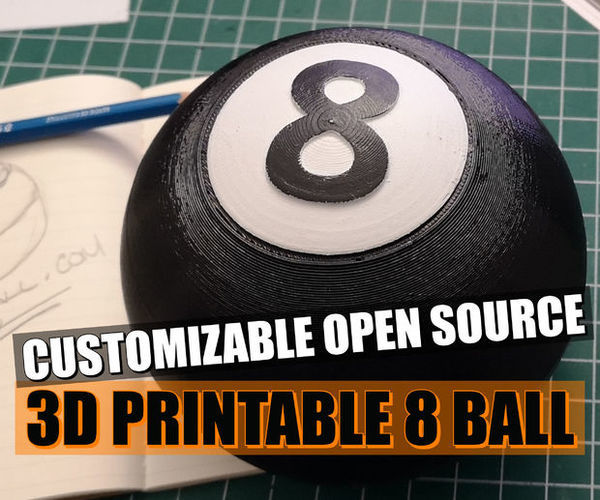
Magic 8 Ball, Open Source, Customizable, Fun and Easy to Build
"The world's first fully customizable, Programmable, Open Source, 3D Printable, Arduino, 8 Ball! This 8 Ball will answer the questions on your mind and help you make decisions ... or maybe you want to play 8 Ball Against Humanity? ... or can't find your D20 ... or ... ... the possibilities are limitless! Everything you need is below in this instuctable to make your own. Let us know what you will have your 8 Ball say or do in the comments below. Maybe we can help you program it!" [...]

Christmas Tree Water Level Indicator
"I built this thing real quick last night so my dad could check the water level without having to crawl underneath the tree. After a handful of requests for parts lists/code on Reddit, I decided the best way to share said information was in the form of an Instructable, so here we are! This instructable was done with the same haste and disregard for quality as the project itself, so I'm sure there will be mistakes. I will add some more pictures to this Instructable later this week. Some Future Plans for This Build: -Possible addition of automatic watering system. Solenoid valve with a gravity fed system is the most likely option." [...]

444 LED Cube Using Arduino Embedded Prototyping Platform
"And a one, and a two! Christmas, Christmas time is here! And so is the time give our homes a colourful festive makeover! This year, were going to up our home-decorating skills and add a touch of DIYing to it by making something totally unique! Presenting to you the DIY Flashing LED Cube - the coolest way to add some colour and light to your life and your home, that too with just some easy-peasy Japan-esy DIYing and some coding. Ready for some electrifying decor?" [...]

ERrigator
"What is eRrigatoreRrigator is what it sounds like. It's an internet connected irrigation controller. HW costs are less than $40 and probably could be pushed down to about $30. It supports up to 6 stations, but more can be added easily if need be. Programming is different than most irrigation controllers. It allows for multiple programs to be set for each station separately from the others." [...]
Interfacing and Fixing Touch Problem on TFT LCD 2.4" Shield
"Interfacing the shield with Arduino UNO board and fixing the touch detection and inversion problem. Hello, in this tutorial I planned to test different functions of the TFT LCD shield but I encountered few problems and decided to show you some solutions first, so the usual tutorial about this shield will follow up later. This is the shield I’m using it’s 2.4″ screen, it can work with Arduino Uno, Leonardo, Duemilanove, Mega… and has a slot for SD card you can use it to store BMP pictures and display them. You just plug it on the top of the board :D. (don’t forget the insulation tape around the usb port so it doesn’t make contact with the screen board) Libraries and codes: So this is where the problems began for me, first you should check for the library that will work for you, to know if a library works or not, download it and open the “graphictest” example, it should show you the different colors and shapes just like in the tutorial video, if you have a white screen you may want to change the library. This is the one that worked for me: Download here Unfortunately I don’t own any other version of the shield to test with a different library. " [...]
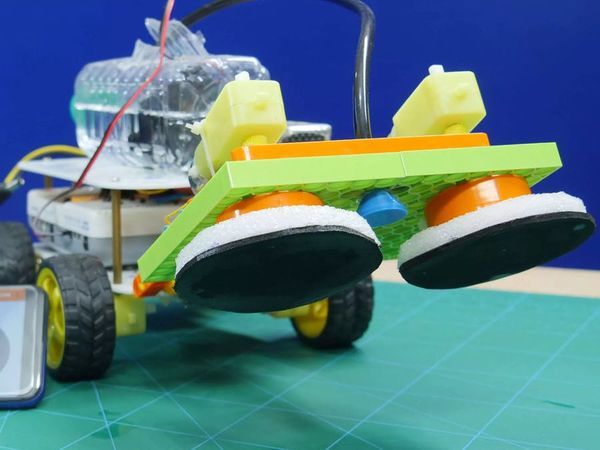
DIY Floor Cleaning Robot Using Arduino
"This project will show you how to make your own smart cleaning robot. While cleaning, getting to those nasty little unreachable spaces under the beds, tables, and sofas can be a big pain. Though small but smart vacuum cleaners are now out there, who wants to spend more than 500 bucks on them when you can make one all by yourself at home under 150 bucks! Yes, you heard us right! It IS possible for you to make your own cute little home cleaner that will scrub your floor and the walls clean with just a few clicks and taps on your Smartphone! Presenting to you the DIY easy to build Smart Cleaning Robot!" [...]
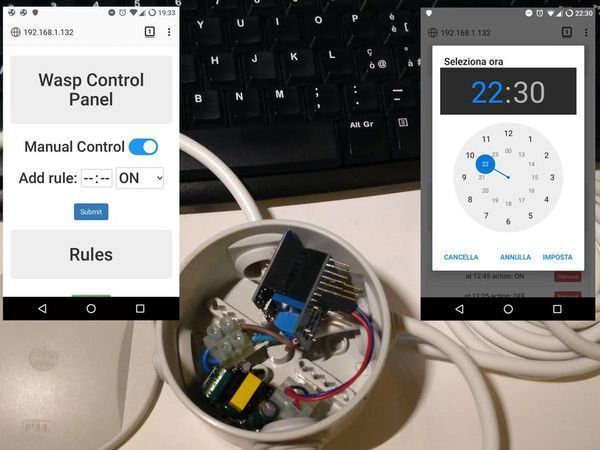
WASP: Wemos Advanced Smart Plug
"WASP is a Wemos D1 Mini time-programmable smart plug with a web-based control interface. WASP is a Wemos D1 Mini time-programmable smart plug with a web-based control interface. With WASP you'll be able to control remotely a 220v power plug and set time rules to switch ON/OFF your powerplug at a given time! " [...]
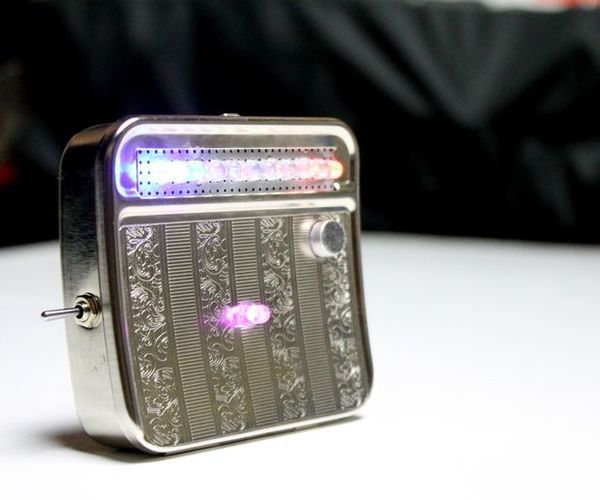
Sound Controlled LED's - Pocket Disco
"Make your own pocket disco with some music controlled LEDs. All you need is some music or sound and theLEDs will dance around to the sound. This is a really run little circuit to build and only needs a few components to make it. The main one being the 4017 IC which is also known as a decade counter. This little integrated circuit can count to 1 to 10 and controls the LEDs. You can use these ICs to build LED chasers (just like Kit from Knightrider) and this build is similar but for one major difference." [...]

Security System
"Build your own security system with motion detection. Project In this project learn how to make security alarm system that is designed to sense if there is movement using a PIR sensor and is able to be armed anddisarmed using the keypad. The circuit is controlled by a Atmel microcontrollerthat is coded in using the Arduino IDE. All of the external devices use male and female headers so it is easy to connect the devices to the PCB without having to solder them permanently to the PCB. The alarm will sound if motion is detected and someone hasn’t entered the correct password in the set time frame.The 7 segment is used to display if the system is armed or disarmed and will display the 4 digit pin used to disarm the device. unfortunately I have lost the code for this project so you will have to code it your self sorry for any inconvenience caused." [...]

LED Mask
" In this tutorial I will show you how I made a replica of the mask worn by norwegian DJ JOWST. This can also be used on any mask you choose. The mask he uses looks kind of like an old welders mask filled with LED's and i think it's really nice looking. Original mask: I had never worked with EVA foam before and had been wanting to for quite a bit so this was a really nice project to get me startet. Mainly what you need is - EVA Foam 2mm thick. - LED strip WS2812B 5050 RGB 60LED/meter - LED controller,vI used NLED ION, - Plastidip or similar rubber spray paint - Barge cement - A power source for your mask." [...]
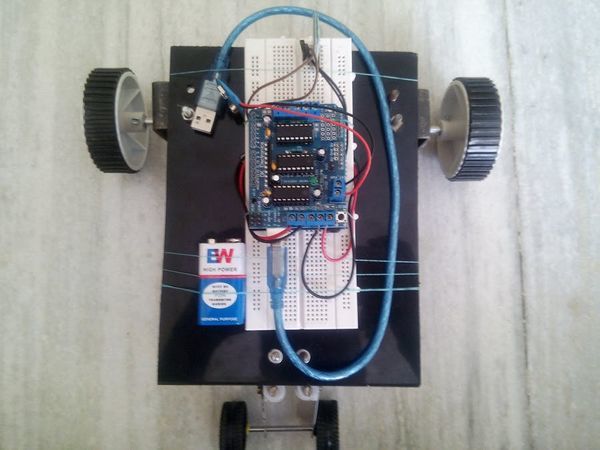
Bluetooth Controlled Car
"This project shows how you can build a car which can be controlled by your smartphone using an android application via Bluetooth. Anything that can be controlled is great. Isn't it? We humans love controlling stuff and that is why automation and robotics so fascinating. This tutorial will teach you how to create your own Bluetooth controlled car. So lets get started." [...]

How to Build a Comfort Monitoring Sensor Station
"This instructable describes the design and construction of a so called Comfort Monitoring Station CoMoS, a combined sensor device for ambient conditions, that was developed at the department of the Built Environment at TUK, Technische Universitt Kaiserslautern, Germany. CoMoS uses an ESP32 controller and sensors for air temperature and relative humidity (Si7021), air velocity (wind sensor rev. C by Modern Device), and globe temperature (DS18B20 in a black bulb), all in a compact, easy-to-build case with visual feedback through an LED indicator (WS2812B). In addition, an illuminance sensor (BH1750) is included to analyze the local visual condition. All sensor data is read periodically and sent through Wi-Fi to a database server, from where it can be used for monitoring and controls. The motivation behind this development is to get a low-cost yet very powerful alternative to laboratory sensor devices, which are typically at a price above 3000 ." [...]

Build Your Own High Resolution, Low Cost 3D Printer
"Over the past years, 3D printing has opened out amazing opportunities to every builder and maker out there to become her/his own independent producer and designer. I have always been amazed by the idea that I can design and print my own parts. I live in a small town and there is only one 3D printing service for miles--and that business definitely takes advantage of their location because it is NOT cheap to get parts printed with them. So, instead of paying a fortune for all the parts I needed, I thought of designing and building my very own 3D printer so that I could print parts whenever I wanted! Conventional 3D printer prices start at about $250 and go up and up! I was able to make one for about $87 with the same functionalities and resolution." [...]

Wire Cutting Machine
"Hello friends I have made a Automatic wire cutting machine using Arduino nano controller board. Basically there are 3 process level of this machine like 1) first process is Input Input like wire length and wire quantity provided by pressing push button also the real time data can read on 16 X 2 LCD 2) Processing all the inputs were processed by arduino nano and give command to stepper motor to feed required length of wire and instruct to servo to make cut of required quantity. 3) Output Stepper motor, servo motor & cutter are the final output component" [...]
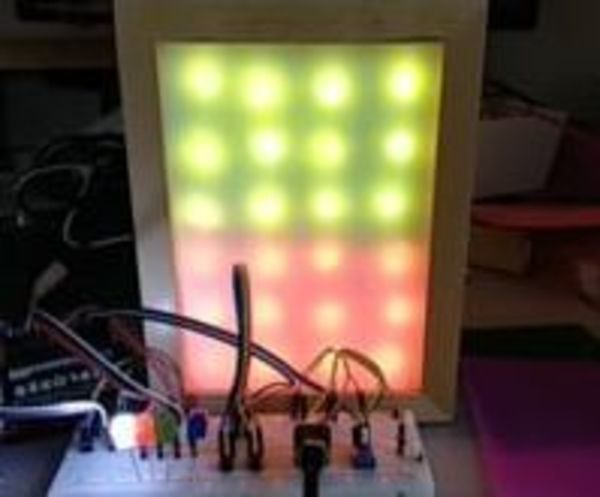
A Breathing Light, Controlled by a Raspbery Pi
"The "Breathing Exercise Light" described here is a simple and relatively inexpensive pulsing light that may support you in your breathing execises and help you to keep a constant breathing rhythm. It could also be used e.g. as a soothing night light for children. In the current stage, it is hardly more than a working prototype. But you may also see it as an inexpensive and simple to build example for "physical computing" with a Raspberry Pi, and it might be used as a educational project on the beginners level. It is based on the Firefly Light example by Pimoroni (see here)." [...]

Efficient Arduino Programming with Arduino CLI and Visual Studio Code
"Introduction The Arduino IDE (integrated development environment) is great at achieving its intended purpose: It’s a simple, single-file application development environment. It has just enough integrated tools to help achieve that purpose. But for larger application development – whether you’re designing Arduino libraries or developing new Arduino cores – it doesn’t compare with a full-featured C/C++ IDE. The Arduino IDE lacks a number of “professional” code-assistance features, like: Code navigation – Whether it’s find-by-reference (instantly navigating to the definition of the function you’re using), search-by-symbol (quick navigation to function or symbol definitions within a file), or a quick link to a compilation error, code navigation is critical to managing large code bases. Auto-Complete – This feature can, of course, help complete long constant names, but it can also provide insight into the parameters that a function may expect. Version control integration – Whether you’re using git or SVN, many modern IDE’s provide source-control integration that can show, line-by-line, the changes you’ve made since your last commit." [...]

Information Station (Arduino)
"Welcome to my latest instructable to build a self contained information station! This awesome device uses an Arduino Uno with an ethernet shield to connect to the internet and pull down latest news and local weather and display it on an LCD display. This project is relitavely inexpensive and has many options for expansion and further work. You can just build the whole thing out on breadboard but if you want to use a nice clean housing there is some soldering required.. So lets get started with the list of components that you will need: 1 Arduino Uno 1 Ethernet Shield. (I use the hanran shield here) 1 4x20 LCD display like this one." [...]
That's all Folks!


